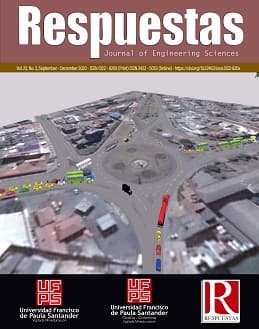Application of the six sigma methodology in the area of paste preparation of a company in the ceramic sector
Aplicación de la metodología seis sigma en el área de preparación pasta de una empresa del sector cerámico
Main Article Content
At present, there are a large number of quality improvement techniques, making it difficult for companies to decide which to apply. In this research, the paste preparation area of a ceramic tile manufacturing company was studied, and the result of this stage is directly reflected in the quality of the final product. The general objective was to apply the Six Sigma methodology in the paste preparation process of a ceramic company; likewise, to evaluate the measurements of the variables that intervene in the paste preparation area of the productive process of a ceramic company and the causes that affect the quality. The application of the six sigma methodology requires the application of statistical tools because the term sigma represents the standard deviation of a distribution and is key to know its variability (Sharma, Bhardwaj, & Kumar, 2013). The implemented methodology is the one proposed in the DMAMC cycle: Design, Measurement, Analysis, Improvement, and Control or DMAIC (Define, Measure, Analyze, Improve, and Control). The critical quality variables were established for each of the three stages of the pasta preparation area: raw materials, grinding, and atomization. The data obtained in the technological tests were organized in tables and graphs, to analyze the results qualitatively and quantitatively, using Minitab and SPSS. As a result, the evaluation of the paste preparation area is obtained, as well as the processing capacity of the different variables of the raw material stage, which exceeds 95%, except for the variables of loss by fire and viscosity. As for the grinding stage, the variable viscosity (Z = 1.45), with a processing capacity equivalent to approximately 85%. There are statistically significant differences. Finally, the variables of the atomization stage have a higher process capacity, 98%.
Downloads
Article Details
S. Sharma, D. Bhardwaj y V. Kumar, «Enfoque Seis Sigma. Aplicación, Beneficios y Alcance,» Internacional Journal of Mechanical Engineering and Robotics Research, 2013.
Y. Park, H. Park y J. Baik, «Un estudio sobre la aplicación de seis sigma para PSPS/TSP para la mejora de procesos,» de 5a Conferencia IEEE/ACIS Internacional de Informática y Ciencias de la información, 2006.
A. R. Khan y L. Zhang, «Applying six sigma in software companies for process improvement,» Blekinge Institute of Technology, Master Thesis, 2008.
G. Nyrén, «A six sigma project at Ericsson Technologies,» Lulea University of Technology, 2007.
V. Kannan, «A study on application of lean six sigma techniques to reduce manufacturing cycle time for an industrial ceramic manufacturing unit,» Journal of contemporary research in management, pp. 23-43, 2017.
P. Mishra y R. Kumar Sharma, «Measuring business performance in aSCN using Six Sigma methodology - a case study,» Internacional Journal of Industrial and Systems Engineering, pp. 76-109, 2017.
I. G. Pérez Vergara y J. A. Rojas López, «Lean, Seis Sigma y Herramientas Cuantitativas: Una experiencia real en el mejoramiento productivo de procesos de la Industria gráfica en Colombia,» Revista de métodos cuantitativos para la economía y la empresa, pp. 259-284, 2019.
N. e. a. Fursule, «La comprensión de los beneficios y limitaciones de la Metodologia Seis Sigma,» Revista Internacional de publicaciones cientificas y de investigación, 2012.
A. Castro Rodríguez y P. Tenorio Hernández, «Diagnostico del área de ventas de una industria farmacéutica basado en la metodologia seis sigma,» Universidad Nacional Autónoma de México, México DF, 2010.
C. Almudéver Marí, «Implementación de la metodologia seis sigma en la construcción,» Universidad Politecnica de Valencia.
H. Gutiérrez Pulido y R. De la Vara Salazar, Control estadistico de calidad y seis sigma, McGraw-Hill, 2005.
C. Huerga Castro, J. Abad González y P. Blanco Alonso, «El papel de la estadística en la metodología seis sigma, una propuesta de actuación en servicios sanitarios,» Pecunia Monográfico, pp. 111-136, 2012.
A. N. d. I. ANDI, «Sector Cerámico,» 2016. [En línea]. Available: http://www.andi.com.co/SectorCeramico/Paginas/default.aspx.
M. Smetkowska y B. Mrugalska, «Using Six Sigma DMAIC to improve the quality of the production process: a case study,» Social and Behavioral Sciences, pp. 590-596, 2018.
J. Cruz Álvarez y P. Arrona Palacios, «Implementación Seis Sigma. Administración de la calidad,» Universidad Autónoma de San Luis Potosí, San Luis Potosí, México, 2006.
T. Costa, F. Silva y L. Pinto Ferreira , «Improve the extrusion process in tire production using six sigma methodology,» Procedia Manufacturing, pp. 1104-1111, 2017.
A. M. Paredes-Rodríguez, «Aplicación de la herramienta Value Stream Mapping a una empresa embaladora de productos de vidrio,» Entramado. Ingenieria y Tecnologia, pp. 262-277, 2017.
Universidad Tecnológica de Bolívar, «Cartilla práctica de Seis Sigma. Fase Medir,» Cartagena de Indias, 2012.
J. I. Vásquez Cervantes, «Filososfia 6-sigma una metodologia para mejorar la calidad de productos y servicios en el sector productivo,» Instituto Politécnico Nacional, México D.F, 2005.
M. Cakmakci, «Process improvement: performance analysis of the setup,» International Journal of Advanced Manufacturing Technology, pp. 168-179, 2009.
C. A. Rey Pinto, «Implementación de la metodología DMAIC Seis Sigma para la reducción del consumo de los materiales indirectos Liquid K, Inoxbril y Enforce LP en la planta de Coca-Cola Femsa Bucaramanga,» Universidad Pontificia Bolivariana, Bucaramanga, 2015.
A. Barrera García, A. Cambra Díaz y J. A. González González, «Implementación de la metodologia seis sigma en la gestión de las mediciones,» Universidad y Sociedad. Revista Científica de la Universidad de Cienfuegos, pp. 8-17, 2017.
SACMI, Tecnologia Cerámica aplcada, Castellón de la Plana: Faenza Editrice Ibérica, 2004.
A. Ruiz- Falcó Rojas, «Introducción a Seis Sigma. Módulo 6,» Universidad Pontificia ICAI ICADE Madrid, Madrid, 2009.







